GOURMET COMPOST WORKSHOP/WEBINAR
/2 Comments/in Gardening/by Lee ReichWEBINAR: GOURMET COMPOST FOR YOUR PLANTS
Learn the why and the how of making a compost that grows healthy and nutritious plants, everything from designing an enclosure to what to add (and what not to add) to what can go wrong (and how to right it). Don’t bother stuffing old tomato stalks, grass clippings, and leaves into plastic bags; just compost them! The same goes for kitchen waste. Learn what free materials are available for composting.
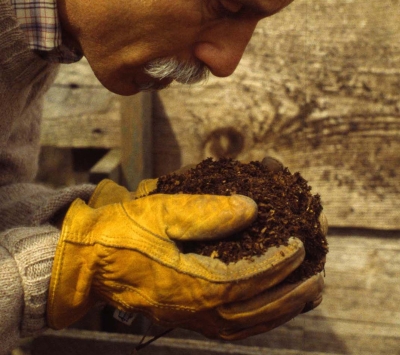 Also covered will be the best ways to use your “gourmet compost.” Good compost is fundamental to good gardening; it put the “organic” into organic gardening, making healthy soil and healthy plants. Plus a segue into compost tea.
Also covered will be the best ways to use your “gourmet compost.” Good compost is fundamental to good gardening; it put the “organic” into organic gardening, making healthy soil and healthy plants. Plus a segue into compost tea.
Whether your interest is to produce a material that’s good for your garden or to recycle kitchen and garden waste, this workshop will teach you all you need to know to make good compost.
Bring your questions.
Date: September 23, 2020
Time: 7-8:30 pm EST
Cost: $35
Register for this webinar at:
https://us02web.zoom.us/webinar/register/WN_XmctJm_9QLWlKmW4hK1Lhg
After registering, you will receive a confirmation email containing information about joining the webinar.
COMPOST, KALE, A FLOWER, AND AN ODD ONION
/8 Comments/in Flowers, Vegetables/by Lee ReichIns and Outs of Compost
Mostly, what I’m doing in the garden these days is making or spreading compost. Lots of good stuff — old vegetable plants, hay, weeds, rotted fruits — is available to feed my compost “pets.” And compost spread now has the ground ready for planting in spring.
Do you have any questions about composting? Want to know how to make best use of co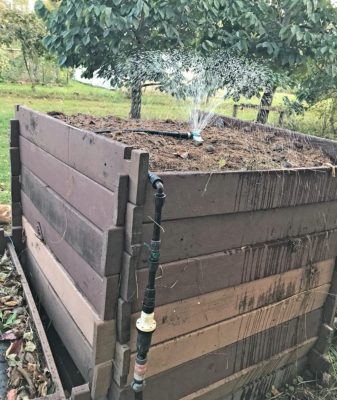 mpost? Interested in details about how to make gourmet compost? This is a reminder that on Wednesday, September 23, 2020 from 7-8:30pm EST, I’ll be hosting a webinar about composting. For more information and registration, go to https://leereich.com/workshops.
mpost? Interested in details about how to make gourmet compost? This is a reminder that on Wednesday, September 23, 2020 from 7-8:30pm EST, I’ll be hosting a webinar about composting. For more information and registration, go to https://leereich.com/workshops.
A recording of the webinar will be available for a limited time period to anyone who registers but can’t make it to the live presentation.
Kale, You’re More than Beautiful
I’m lucky enough to have a French window of two big, inward swinging panels out of which I can look over my vegetable garden every morning. Oddly enough, the garden bed that is catching my eyes these mornings for its beauty is the bed mostly of kale plants.
No, it’s not a bed of colorful, ornamental kale, not even a reddish kale such as Russian Red. I grow just plain old Blue Curled Scotch kale, which is no more bluish than any other kale, or any other member of the whole cabbage family for that matter. What catches my eye each morning is the way the curly leaves flow together like an undulating wave of verdant frilliness.
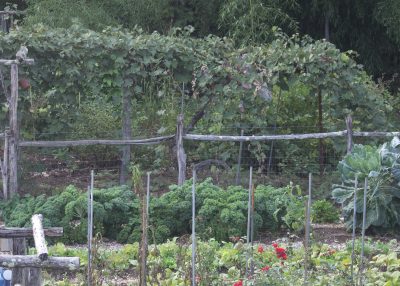
My vision could be swayed by my knowing that kale is such a healthful vegetable, being especially rich in calcium and vitamin A. Or the fact that it’s so easy to grow. I sowed the seeds in early March, set out transplants out in early May, have been harvesting it since the end of May, and will continue to do so probably well into December. (Another bed of kale, which I seeded right out in the ground at the end of May, is also looking good.)
Unlike broccoli, whose prime is past once buds open into flowers, or cabbage, which splits if left too long, kale doesn’t need to be harvested at just the right moment. It just keeps growing taller, with more leaves, if left alone.
The only thing kale needs protection from is rabbits and woodchucks, like most vegetables, and from cabbage worms. A fence and two dogs keep rabbits at bay. One or two sprays of the biological pesticide Bacillus thurengiensis, sold commercially under such trade names as Thuricide and Dipel, is all that’s needed for the worms (they’re actually caterpillars, not worms). Or nothing. Some years, damage is light enough so that no control is necessary.
What more could I ask for from a plant: good looks, good health, and good flavor?
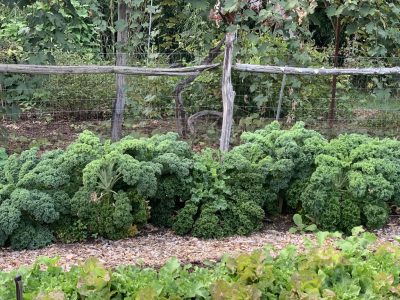
Kiss Me Over the Garden Gate
I take it upon myself to personally promote the revival of an old-fashioned flower: kiss-me-over-the-garden-gate (Persicaria orientalis). It’s big, it’s beautiful, and it’s distinctly old-fashioned.
If you know the weed called smartweed, you have a hint of what kiss-me-over-the-garden-gate looks like. Smartweed is a trailing weed, usually no more than a foot or so high, with what look like small droplets of pink dew at the ends of its stems.
Kiss-me-over-the-garden-gate looks like smartweed on steroids, the “droplets” the size of bb’s and, rather than trailing, the plant rises with robust arching stems to more than seven feet high. It’s just the right height and form for growing next to a garden gate, which is where my plants sometimes grow.
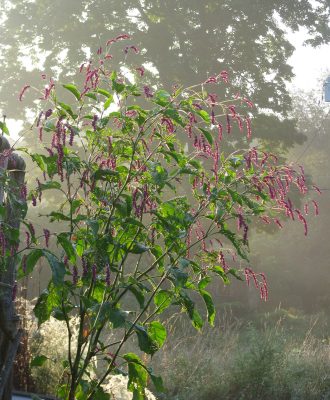
Kiss-me-over-the-garden-gate is a little hard to get started because the seeds germinate slowly and erratically. My plants thankfully live up to their reputation of being self-seeding annuals. The self-seeding plants come up more robustly than the coddled few seedlings I used to transplant each year.
Kiss-me-over-the-garden-gate’s self-seeding habit is restrained enough to keep it from being frightening. All I do each spring is weed out the few extra plants, as well as those that stray too far from my garden’s gate.
Evergreen Onions
For many years, in addition to starting onions from seed, sown in February, I also would go the more conventional route and bought a few “sets” for planting. Sets are those small bulbs that grow first to become scallions, which are mostly leaf, then go on to fatten into bulbs that can be harvested and stored.
Nowadays, instead of planting sets for scallions, I grow bunching onions, yet another type of onion, one that never ever makes fat bulbs. I’ve sown them in February for later transplanting, or directly in the garden. They always remain scallions, never bulbing up, and multiply by growing new baby plants at their bases.
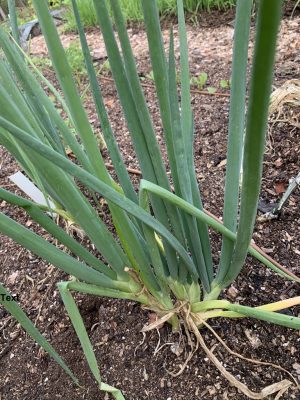
The variety I grow, Evergreen Hardy White, can allegedly live through winters here. Come spring, the plants can be divided to make more scallions for eating and for growing. (I’ve always eaten them all; this year I’ll leave some to challenge their winter hardiness.)
Tops of my bulbing onions dried down and were harvested weeks ago, but these bunching onions never cease to maintain their fresh, green scallion-y character.
I’M NO MICHELANGELO, BUT . . .
/5 Comments/in Design, Pruning/by Lee ReichLawn Nouveau
I’m taking up sculpture. Not in bronze, Carrara marble, or granite, but with plants.
My easiest sculpture is one I’ve been doing for years. I can’t really say “working on for years” because every year it vanishes, to be started anew each spring. It’s “lawn nouveau,” as I call it in my book, The Pruning Book, and then go on to describe the technique as “two tiers of grassy growth . . . the low grass is just like any other lawn, and kept that way with a lawnmower. The taller portions are mowed infrequently – one to three times a year, depending on the desired look (and my need for hay) — with a scythe or tractor.” The sharp, defining line between the high grass and the low grass is integral to the design.

I’m lucky to have a meadow bathed in sunlight bordering the south side of my property. But even a small yard might be able to accommodate lawn nouveau. My three-quarter of an acre yard did before the meadow shifted to my care. (Previous owners had maintained it as very large lawn with weekly or biweekly mowing.)
This sculpture has many pieces to it.
One is how I manage it with mowing the whole meadow either at the end or the beginning of the growing season, a necessary task or the meadow will naturally revert over time to forest. Even a once a year mowing might be insufficient, as I realized a couple of years ago with the increasing encroachment of woody shrubs and vines such as poison ivy, grape, and multiflora rose.
Repeated mowing during one season brought the meadow back in order, mostly with grasses. Over time I expect and hope for a resurgence also of more goldenrods, bee balms, and other herbaceous, flowering plants.

The look of the meadow is also influenced by a season’s weather. And by the progress of the season, the meadow’s appearance being very different as grasses morph from succulent green leaves in spring to late summer’s tawny shoots and seed heads. Late summer also brings on showy flowers.
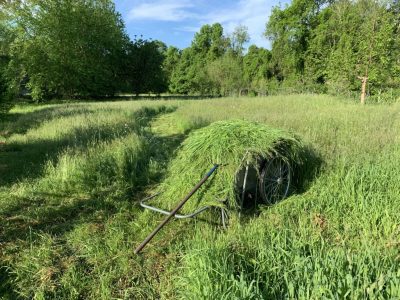
Even the time of day; it’s early morning appearance is quite different than its appearance at various times throughout the day, all dependent also, of course, on what’s happening up in the sky. All this making for a very interesting sight of varying beauty.
A lot of this is either beyond my control or very unpredictable. What is neither is my mowing during the growing season. Each spring I lay out a path, maintained by mowing with my tractor, that wends its way through the meadow.

The goal is to make it inviting and practical. Practical because it carries you to the end of the meadow into a bosk of maples, river birches, and one large buartnut tree, and then on to a studio building.


This year I decided to also sculpt more edges of the meadow, cutting the high grass with a scythe to a pattern that matches the flow of the path within. One of my favorite views of the meadow is from an upstairs window, its height allowing me to visually swallow the whole view.
A Head for Yew
Another plant sculpture here is a large yew that I’m carving to become a fifteen foot high head. This one is easy enough because I’m merely copying one of a series of such heads living in a public garden in Britain.
The bush is old, 40 years at least, and has always been pruned to a cone shape with slightly rounded rather than straight sides.
Creating the facial features has involved some deep pruning down into the center of the bush. Yew is a forgiving plant, readily resprouting from even old wood. Problem is that some of those interior stems are old and dead.
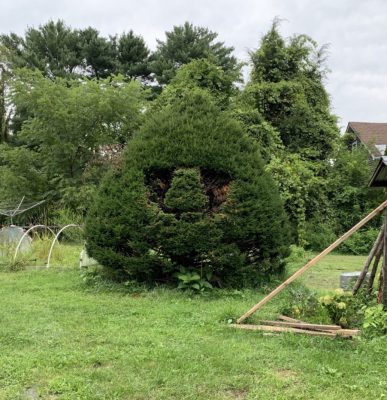
The challenge, then, is time, to be patient for sprouts to grow where light now is penetrating. And then to trim those sprouts so that all levels of the sculpture present green surfaces.
Cloudy Aspirations
And finally, my most difficult sculpture, one for which I each year claim improvement, but not success. The plants: yews again. In this case, there are four of them, all maintained four to five feet high so as not to block the windows of the wall they front.
Originally, they were pruned as a standard yew-along-house-foundation hedge. A few years ago, I morphed them into something more interesting and humorous, a giant caterpillar, with some success. (My inspiration here was the work of Keith Buesing, topiarist extraordinaire of Gardiner, New York.)
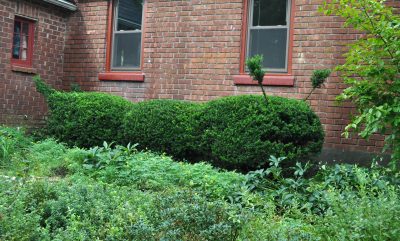
More recently for these plants, I decided to try a method of pruning known as okarikomi, a technique that originated in Japan. In this case, a group of shrubs, rather than maintaining their individual identity, are pruned to flow together to create a scene reminiscent of billowing clouds or a distant, rolling landscape.
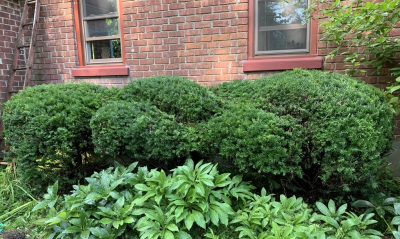
Thus far, I’m not pleased with my pruning. But every year I make some changes and it looks better than it did the previous year.
Plants are very forgiving. Every year, even during each growing season, I have opportunity to change my sculptures according to my whims or what looks nicer to me. What will the meadow, the yew head, and the okarikomi yews look like next year?
And Composting
In case you didn’t notice my previous post, I will be holding a composting workshop/webinar Wednesday, September 23, 2020 at 7 PM. For more information, go to www.leereich.com/workshops.

